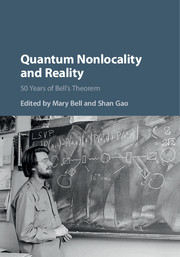Book contents
- Frontmatter
- Contents
- Contributors
- Preface
- Preface
- Part I John Stewart Bell: The Physicist
- Part II Bell's Theorem
- Part III Nonlocality: Illusion or Reality?
- 9 Strengthening Bell's Theorem: Removing the Hidden-Variable Assumption
- 10 Is Any Theory Compatible with the Quantum Predictions Necessarily Nonlocal?
- 11 Local Causality, Probability and Explanation
- 12 The Bell Inequality and the Many-Worlds Interpretation
- 13 Quantum Solipsism and Nonlocality
- 14 Lessons of Bell's Theorem: Nonlocality, Yes; Action at a Distance, Not Necessarily
- 15 Bell Nonlocality, Hardy's Paradox and Hyperplane Dependence
- 16 Some Thoughts on Quantum Nonlocality and Its Apparent Incompatibility with Relativity
- 17 A Reasonable Thing That Just Might Work
- 18 Weak Values and Quantum Nonlocality
- Part IV Nonlocal Realistic Theories
- Index
- References
16 - Some Thoughts on Quantum Nonlocality and Its Apparent Incompatibility with Relativity
from Part III - Nonlocality: Illusion or Reality?
Published online by Cambridge University Press: 05 September 2016
- Frontmatter
- Contents
- Contributors
- Preface
- Preface
- Part I John Stewart Bell: The Physicist
- Part II Bell's Theorem
- Part III Nonlocality: Illusion or Reality?
- 9 Strengthening Bell's Theorem: Removing the Hidden-Variable Assumption
- 10 Is Any Theory Compatible with the Quantum Predictions Necessarily Nonlocal?
- 11 Local Causality, Probability and Explanation
- 12 The Bell Inequality and the Many-Worlds Interpretation
- 13 Quantum Solipsism and Nonlocality
- 14 Lessons of Bell's Theorem: Nonlocality, Yes; Action at a Distance, Not Necessarily
- 15 Bell Nonlocality, Hardy's Paradox and Hyperplane Dependence
- 16 Some Thoughts on Quantum Nonlocality and Its Apparent Incompatibility with Relativity
- 17 A Reasonable Thing That Just Might Work
- 18 Weak Values and Quantum Nonlocality
- Part IV Nonlocal Realistic Theories
- Index
- References
Summary
It may well be that a relativistic version of the theory, while Lorentz invariant and local at the observational level, may be necessarily non-local and with a preferred frame (or aether) at the fundamental level.
– John Bell [1]Introduction
Bell's theorem establishes a contradiction between locality (and a few other assumptions) and certain predictions of quantum mechanics [2]. There have been two main issues surrounding the deep implications of this celebrated theorem. The first issue is basic, and it concerns whether the theorem really establishes that nonlocality is a necessary feature of any empirically viable theory and hence a feature of nature itself. One aspect of the issue concerns exactly what the underlying assumptions of Bell's theorem are. For example, some argue that these assumptions include the assumption of counterfactual definiteness [3–5], while others disagree [6–8]. The other aspect of the issue concerns which assumption should be dropped due to the resulting contradiction. Some believe that standard quantum mechanics may avoid nonlocality by denying counterfactual definiteness [3–5].
The second issue is much deeper, and it concerns how to make sense of the strange nonlocality when assuming that Bell's theorem establishes that our world is nonlocal. In particular, it has yet to be determined whether such quantum nonlocality is compatible with the theory of relativity, e.g., whether the nonlocality requires the existence of a preferred Lorentz frame [7, 9, 10]. It seems that “there is a preferred frame of reference, and in this preferred frame of reference things do go faster than light … Behind the apparent Lorentz invariance of the phenomena, there is a deeper level which is not Lorentz invariant” [11]. But it also seems possible that the existence of a preferred Lorentz frame is an illusion, since it cannot be detected according to standard quantum mechanics. A more subtle issue is whether quantum nonlocality permits superluminal signaling. It is widely thought that the answers to these questions will lead to a deeper understanding of Bell's theorem and quantum nonlocality.
In this paper, we will present a new analysis of quantum nonlocality and its apparent incompatibility with relativity.
- Type
- Chapter
- Information
- Quantum Nonlocality and Reality50 Years of Bell's Theorem, pp. 281 - 294Publisher: Cambridge University PressPrint publication year: 2016



